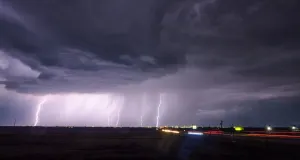
Viral Weather: How COVID-19 modelling relates to climate change
From our Viral Weather program: Chris St. Clair speaks to a panel of experts on the parallels between modelling the COVID-19 pandemic's effects, and modelling climate change impacts.
COVID-19, and the way scientists and modellers and citizens have reacted to it, shines a light on how the world might process a rise in climate change-related diseases as the world warms. We spoke to a panel of experts on the parallels and differences in approaches to the two crises.
EXAMINING THE INPUTS TO DISCERN AND INFLUENCE THE OUTPUTS
As the COVID-19 pandemic continues, most people have absorbed the message about 'flattening the curve,' with the logic that more people physical distancing can check the spread of the virus enough to prevent hospitals being overwhelmed with those people who DO get sick.
Péter K. Molnár, Assistant Professor in the Department of Biological Science at the University of Toronto, told The Weather Network's 'viral weather' panel that approach -- trying to influence or control the inputs of the disease to influence its behaviour and outcome -- has some parallels to climate change as well.
Molnár says researchers use 'mechanistic' models to assess the disease: Trying to examine its mechanists to determine how many will fall sick, or die, then try and extrapolate from that model the disease's future progression.
He explains: "If you take a soccer ball and drop it 10 metres, then you can tell me that soccer ball is going to fall, and based on the laws of gravity, I can calculate how fast it will do that, and all these other things."
In the case of COVID-19, its mechanisms include things such as speed of transmission, number of infections, recoveries and deaths, all of which will influence how the curve develops, and how fast it will flatten.
"If we change the mechanisms by telling people to stay home, we essentially alter the transmission rate, and we alter the disease dynamics," he says.
When assessing the impacts of climate change, he says, the method is similar, though the questions that go into determining the mechanisms are different (for example, how do temperature changes influence particular diseases' transmission efficiency, and how will mosquito numbers change).
One major factor shared by future climate change-influenced diseases, and the COVID-19 outbreak, is the human factor.
"How do we actually, either react to such diseases or, how do we plan ahead of time and influence what will happen by doing so?" he says. "And of course, that's in some sense, up to all of us, and our politicians and leaders, and what we do in our everyday life."
FUTURE MODELLING AND CLIMATE CHANGE PLANS
As with COVID-19, the outbreak of other diseases, such as Ebola in Africa, prompts a government response, which can vary depending on the region and state.
Neil Osborne, The Weather Network's climate change editor, recalls visiting the Democratic Republic of Congo as part of a climate change assignment a few years ago amid an Ebola outbreak, and was "very impressed" with how quickly his group was told to put on a mask. But planning for climate change can be trickier than planning for an infectious disease outbreak.
"I think the point to make here is, how important is a plan?" he asks. "You could argue some countries were slower to react than others, but at least from my perspective in Toronto, my neighbours, we're staying at home. There's a plan, there's something very tangible we can do ... for climate change, that plan isn't so tangible, is it?"
Dr. Marta Shocket, a biologist at the University of California, Los Angeles, adds she was herself checked for COVID-19 three weeks ago in the U.S., and after several tests, was told to go home and self-isolate.
She noted that her part of California has held up relatively well, in the sense that the hospital system appears to be keeping pace with the amount of cases, but other countries may not have the same resources -- a preview of the kind of country-to-country disparities in dealing with the effects of climate change.
"Not every community has the same amount of resources to deal with climate change, and of course, disadvantaged communities are going to be affected by climate change more strongly," she says.
Watch the full 'Viral Weather' episode below:










